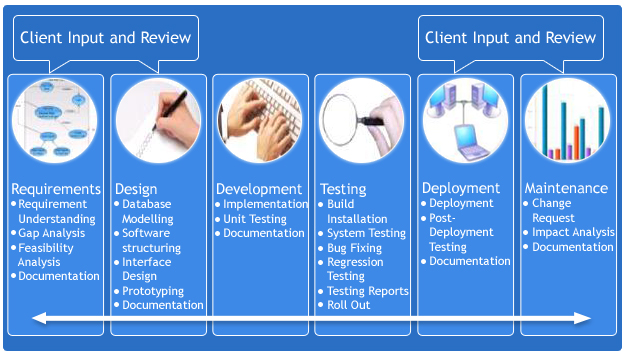TechHighway offers following services with well defined processes and effective implementation of the knowledge, gained over 15 years of experience.

Areas of Expertise Across Domains:
- Web based applications
- Web services
- Web service security models (WSE 3.0)
- Standalone desktop applications
- B2B & B2C solutions
- Instrument interface
- Web scraping
- Plugin development for browsers such as IE and FireFox
- Intelligent report generation in various formats (HTML, XLS, CSV, PDF)
- Corporate Website Development
- Content management system (WordPress, Joomla, Drupal, DotnetNuke, MojoPortal, Open CMS)
- Search engine optimization techniques
- Various website tracking tools such as Google analytics, Google adwords, Post-Click tracking, C2C tracking, eSearch vision tracking, Google website optimizer, ClickTale etc.
- Mobile and iPhone application development
- Ubersmith integration
- Application Testing
- End-to-End Testing Services
- Requirements validation
- Functional testing
- Performance testing
- Load testing
- Regression testing
- Test automation
With our strong experience in this field we have built up robust development cycle model which is efficient and result oriented.

Above depicted model allows us to resolve the problems observed in particular phase in the same phase. It does not let the problem grow and produce any severe impacts. This in turn reduces the development cost in totality.
Following sections describe each phase by detailing various activities performed during the implementation cycle.
1. Requirements
This is the beginning phase of the cycle. It is essential to have a close interaction between business system specialist from client’s side and project manager from our side to formulate the requirements.
This phase includes –
- Studying existing manual system (if any)
- Identifying the functions to be incorporated in software system
- Converting these functions into system requirements
- Gap analysis
- Analyzing the requirements
- Project scheduling
- Documenting and reviewing the requirements
2. Design
Design phase uses Requirement understanding document as a base and is very crucial in the whole cycle. The outcome of this phase is the technical blueprint of the system. The success of Development phase depends on how much detailing is done during Design phase. We make sure that technical experts from our side are involved in design reviews and provide important timely inputs.
This phase includes –
- Creating the best possible technical architecture of the system
- Database modeling
- Designing presentation layer (Graphical user interface)
- Designing business layer
- Documenting and reviewing the design
- Creating system test plan
- Creating system test cases
3. Development
This is the phase where actual execution of the design into an implementation of software system is done. If design phase is executed with a deep thinking, Development phase gets executed without many complications.
This phase includes –
- Building database structure
- Implementing software layers
- Implementing Graphical user interface
- Code reviews
- Creating unit test cases
- Carrying out unit testing of each and every piece of implemented software
4. Testing
In this phase validation and verification of the software system is done. Our team is equipped to perform manual and automatic testing. We take care of end to end testing, functional testing, integration testing, regression testing, acceptance testing.
This phase includes –
- Planning the testing
- Installing the build on staging / test environment
- Executing system test cases
- Ad-hoc testing
- Executing automatic test scripts (if any)
- Logging bugs observed
- Regression testing
- Generating test reports
- Rolling out the build
5. Deployment
This is the phase where deployment on various staging and production environment is done. Input to this phase is tested build on test and various staging environment.
This phase includes –
- Creating user guide
- Creating installation guide
- Installation on production environment
- Carrying out system test cases on production environment
- Resolving issues related to environment (if any)
- Final roll out
6. Maintenance
Software does undergo changes even after it is delivered. There can be various reasons for such changes. We are responsive and flexible to accommodate such changes in meticulous manner. While designing the system, we make sure that the design is scalable.
This phase includes –
- Understanding change request
- Impact analysis
- Modification
- Regression testing
- Deployment
